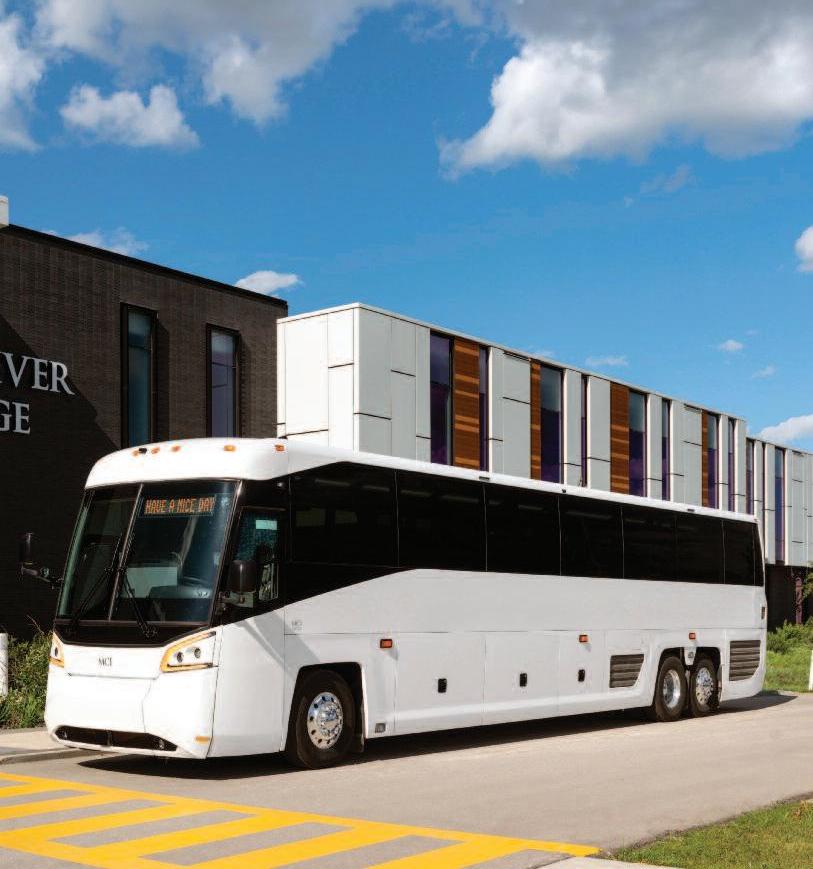
18 minute read
D is for Durability –Introducing the New MCI D4520 by Larry Plachno
from NBT The Magazine of Bus Equipment for the United States and Canada Volume XLIV,No.9 August 2021
Anyone watching the industry is aware that the traditional MCI “D” model coach line is in the process of morphing into new designs, new models and new systems or options. What we are going to do is to provide a status report on where things stand on the changing “D” models and then highlight the newest addition to the product line – the new D4520.
The MCI “D” series is getting to be one of the longest running and most popular coach models of all time. Its roots go back to the early days at MCI when founder Harry Zoltok was challenged to build a coach that could be reliable and durable on Canadian roads in all weather conditions. MCI was so successful that it became part of Greyhound for several years and took over as the most popular coach brand – a position it continues to hold today.
Advertisement
This durability and reliability continued through 35-foot models 1 through 5 and 40foot models 6 through 9 plus 12. In the mid1980s, MCI moved to letter designations for 40-foot models A, B and C. Two factors combined that led to the introduction of the “D” model series. One was the move to 45-foot coaches while the second was the move to the new Detroit Series 60 engine since it was too large to fit in the engine compartments of current models.
Although not yet sanctioned on the federal level, the industry started looking at moving up to a 45-foot length. MCI’s first venture with this longer length came in late 1989 when it built a 45-foot conversion shell based on the 102C3 model that went to a company that built it into an entertainer coach. This was followed by a partnership with the Canadian government to build an accessible coach for the people with disabilities. It had a length of 45 feet and made a debut at the MCI Winnipeg facility on May 8, 1990.
Noteworthy features of this coach included a lift for mobility devices on the curbside behind the wheels. A large accessible restroom was located at the rear of the coach, easily reached from the mobility device securement locations. It also offered some improved systems and technology including an anti-lock braking system.
On December 18, 1991, the Intermodal Surface Transportation Efficiency Act was signed into law, allowing an increase in coach length to 45 feet on interstate and federal aid highways. Less than three months later, in February of 1992, MCI introduced their new “D” series as the 102DL3 at the UBOA Bus Expo in Chicago. Regular production started late in 1992. The model number represented 102 inches wide, D model, L for long – a length of 45 feet and three axles. While the first of the D models was 45-feet long, a companion 40-foot D model, the 102D3, soon replaced the “B” and “C” models in the MCI product line.
I think it would be fair to say that the MCI “D” models went on to enjoy a great deal of success and continued their tradition of reliability and durability. Responding to customer requests, MCI introduced their new “E” model Renaissance® in 1998 and the new “J” model in 2001 with an attractive body design suited to tours and high class charters. Meanwhile, the “D” model coaches continued to be particularly popular in commuter coach and scheduled service applications.
In 2006, at the request of several scheduled service operators, MCI gave the “D” models a facelift with a more modern appearance. This resulted in a D4500 model geared towards public sector commuter coach operations as well as the newer design D4505 (the ’05 referencing roughly the year
D is for Durability
Introducing the New MCI D4520
by Larry Plachno
Photos courtesy of MCI
MCI’s new D4520 model leads the movement from the Legacy “D” models in the MCI product line to the Next Generation “D” models. As such, it represents a combination of the traditional MCI durability and reliability heritage with the new design and developments fostered by the D45 CRT LE model. The D4520 is expected to be particularly popular with private scheduled service operators and in operations requiring extra durability. It will replace the D4505 model in the MCI product line.
of update) geared towards private sector scheduled service. Companion 40-foot models were designated as D4000 and D4005. In addition, MCI continued to offer an Inmate Security Transportation Vehicle to various government and police agencies for the transport of prisoners. It might be noted that since the “D” models are finished at MCI’s facility in Pembina, North Dakota, they comply with Buy America provisions.
What we can do to make things as easy to understand as possible is that we will cover the current or Legacy “D” models that are still in production. Then, we will briefly look at the new two-door Commuter Rapid Transit “D” models that offer both a traditional front and a center low entry. From there we can talk about the new D4520 and the companion models that will eventually replace the Legacy Models.
Legacy Models
MCI’s Legacy Models date back to 1992 and continue the MCI tradition for durability and reliability. Various people in the industry have referred to them as “ workhorses” and as the bus equivalent of the Sherman Tank. They are popular in rugged daily service including commuter operations and scheduled route service. In common with other “D” models, they comply with Buy America provisions for typical government funding.
All five models listed here are in production as of mid-2021 and available for orders but will eventually be replaced by the new models that include the D4520 and its companions. None of these Legacy Models are available with battery-electric power, but the new D4520 will be.
• D4000 – This is the 40-foot version of the traditional “D” model. It was originally introduced in 1994 as the 102D3 and was the replacement for the previous “B” and “C” models. Over the years it has developed an enviable reputation as a public sector commuter coach and has served well in numerous cities. The standard power train includes a Cummins clean diesel engine and an Allison B500 transmission.
• D4500 – As you might expect, this is the 45-foot version of the traditional “D” model. It is the oldest of this series and was originally introduced in 1992 as the 102DL3. Since it was the first 45-foot coach in the regular MCI product line, it did not replace a previous model. Like the shorter D4000, the D4500 has been increasingly popular as a public sector commuter coach and can be found in the commuter fleets of several cities. The Cummins/Allison power train is standard.
• D4005 – At the request of private sector operators, the D4000 was given a facelift in 2006 and emerged as the 40-foot D4005 model. Mechanically, it is similar to the D4000 but has become popular in private sector scheduled service and some charter applications. It has the same power train as the other Legacy Models.
• D4505 – As you might expect, this is the 45-foot version of the D4005. It has the new appearance and is also popular in private sector scheduled service and some charter applications. It is mechanically similar to the D4500 and offers the same power train.
• D4000 ISTV – The fifth coach of the Legacy Models is the D4000 ISTV. The letters
What is now called the Legacy “D” coach series started with the 102DL3 model that was introduced in 1992 as MCI’s first 45-foot coach. Over the years the model number changed to D4500 and it increasingly became popular as a commuter coach. This model is the leader in the commuter coach market and operates in several cities.
For private operators, the Legacy “D” coach series was updated in 2005 with the D4505 model. It gave a more modern appearance to this coach that was a workhorse in many fleets. It went on to be popular in scheduled route service and in special services that required extra durability.
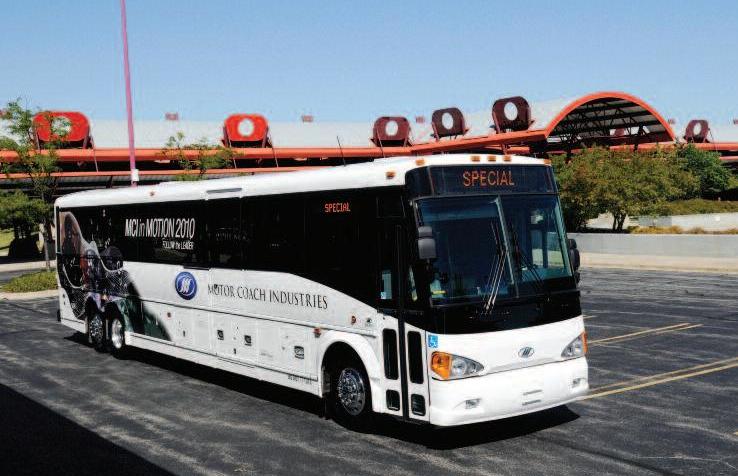
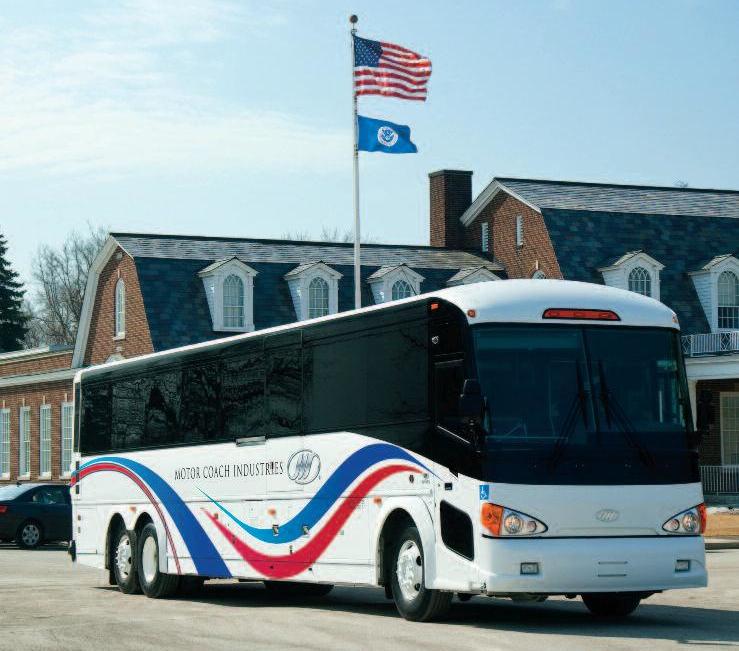
stand for Inmate Security Transportation Vehicle. This coach design was originally offered back in the “number model” days and has been upgraded through the years. It is primarily used to securely transport inmates between courthouses and prisons. States have several of these in service and it is also used by other government agencies. The 40-foot length is a requirement to fit within most prison sally ports. MCI provides special interiors that offer different degrees of security while making sure that seat parts and other interior items cannot be used by the passengers.
D45 CRT LE Model
The movement to the new “D” models actually starts with the recently introduced D45 CRT LE that is both revolutionary and evolutionary. Introduced at the APTAExpo in 2017, it went into production in late 2018. Some people in the industry have called it the most revolutionary motorcoach since the Scenicruiser that was introduced in 1954.
There was another revolution back in the mid-1930s when motorcoaches began changing design to higher passenger levels and underfloor luggage. This offered several advantages. Instead of being carried on the roof, luggage was now protected from the elements. Passengers now rode above most of the traffic, had a better view and arguably were safer. This same basic design for motorcoaches continues to today – nearly 90 years later.
With the arrival of the American’s with Disabilities Act (ADA), buses were now required to provide access for people in wheelchairs and other mobility devices. Initial efforts involved using lifts that were awkward, slow and sometimes required a great deal of attention. The city transit bus people solved this problem by building their buses closer to the ground. This permitted a change from lifts to ramps that not only made things easer and safer but also speeded up entry and exit considerably. However, hampered by those lower level luggage compartments and high passenger levels, the motorcoach operators continued to use lifts.
The MCI D45 CRT LE is revolutionary because it offers a motorcoach that does not need a lift. In addition to the regular front door for ambulatory passengers, it is the first single-deck coach model to offer a center door at curb level for mobility devices that enter into a lower level compartment using a simple ramp. There is room inside this area for two mobility devices and a companion. Hence, entry and exit for mobility devices is quicker, easier and safer. It should be noted that the unit was developed with significant input from people with disabilities from organizations such as NCIL and AAPD.
Of more relevance to our discussion of improved “D” models is the fact that the D45 CRT LE was evolutionary as well as revolutionary. In developing the D45 CRT LE, the MCI engineers started off with a clean slate. As a result, they were able to take advantage of new styling as well as state-of-the art systems and components. This new technology and design will now be available for developing the Next Generation “D” models that some are also calling the new high-floor models.
The Next Generation “D” Models
While I would like to concentrate on the new D4520, let me briefly run through the new Next Generation “D” models that will include the new design and technology developed with the D45 CRT LE and will eventually replace the Legacy Models. The public sector models are Altoona tested and comply with Buy America requirements.
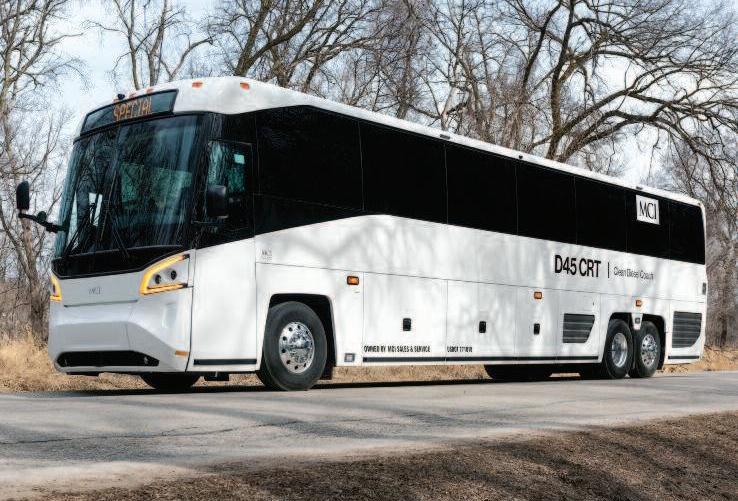
The new D45 CRT is a high level coach in the Next Generation of “D” models. It is designed particularly for the public sector commuter market and is expected to find use in numerous cities. The D45 CRT incorporates features of the D45 CRT LE in a single level coach and hence is the effective replacement for the Legacy D4500 model.
The “game changer” for the “D” series of coaches came with the introduction of the new D45 CRT LE model in 2017. Revolutionary in design and incorporating new technology, this model offered both a conventional front entrance for ambulatory passengers as well as a low middle entry for mobility devices. Now, the new design and technology of the D45 CRT LE is being used to create the Next Generation of “D” models.
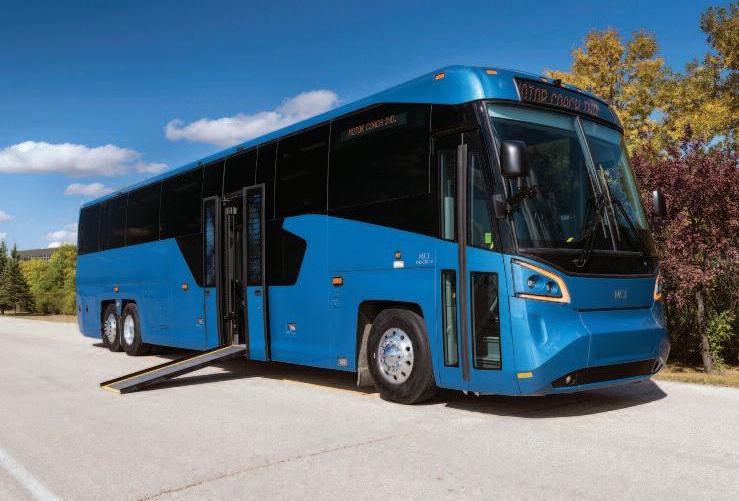

Since it is designed primarily for public sector commuter coach operations, the D45 CRT will come with a center lift for mobility devices. The D45 CRT will have several optional power sources to meet different needs including clean diesel, battery-electric and CNG power.
Passengers will find that the D45 CRT provides a high level of comfort and amenities. In addition to overhead parcel racks, riders can take advantage of comfortable seats plus overhead reading lights and vents. Other amenities like Wi-Fi and electrical outlets are available.
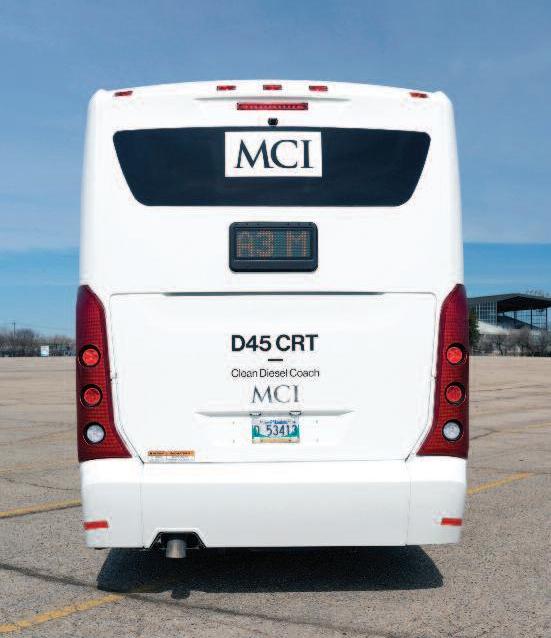
• D4520 – Already in production, this is the new 45-foot model that effectively replaces the D4505. It will be available with either clean diesel or battery electric power. This model is expected to be popular with scheduled routes and other applications requiring durability.
• D45 CRT – This 45-foot Commuter Rapid Transit model is already in production and will replace the current D4500. It is a high-level coach designed especially for commuter applications but without the lower entry of the D45 CRT LE. It will be available with clean diesel, battery-electric and CNG power.
• D40 CRT – With a length of 40 feet, this model will be the shorter companion to the D45 CRT. It will be a high-level coach geared towards public sector commuter coach operations. As such, it will replace the D4000 in the MCI product line. The D40 CRT will be powered by clean diesel and will enter production in the future.
• D4020 – As you probably have already guessed, this is a 40-foot model. It will be the shorter companion model to the D4520 and effectively replaces the existing D4005 model. The D4020 will have application to both the private and public sectors and will be powered by a clean diesel engine. It has not been launched as of this writing.
• D4020 ISTV – This will be a 40-foot coach and the new version of the Inmate Security Transportation Vehicle. It has not yet been launched but will replace the current D4000 ISTV. It will have clean diesel power and can be used by either private or pubic sector operators.
When the MCI engineers started to work on the new D45 CRT LE, they were aware that their new design and improvements would eventually replace the Legacy “D” coach models, the best-selling coach series of all time. Emphasis was placed on customer feedback and modernizing the traditional design while still delivering the reliability and durability that gave the “D” models the reputation of a workhorse.
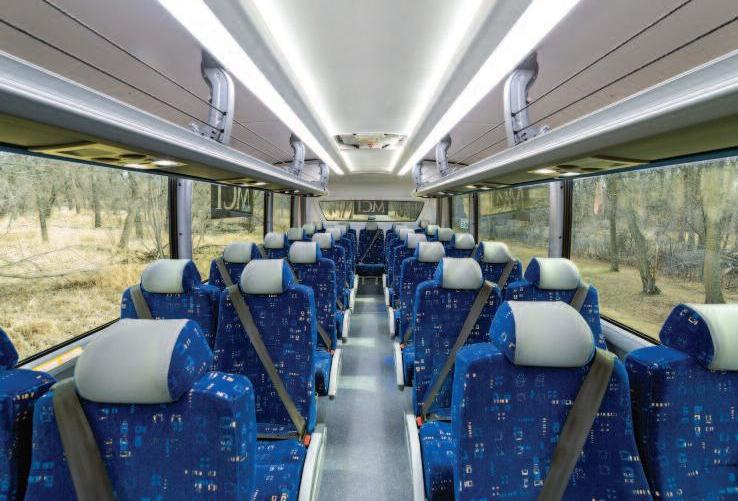
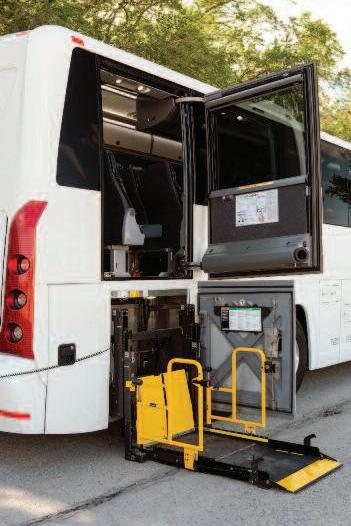
The wheelchair lift on the D4520 is placed at the rear of the coach. This eliminates the need to reduce underfloor luggage space.
Several important points were at the core of the development program. One of the most important was retaining reliability and durability while providing common systems and production on the various models to improve training, parts availability and support. Cost of operation entered into the picture in several ways and fostered the custom-designed energy absorbing bumpers.
Interiors were designed for maximum legroom while still providing specific needs. For example, the D45 CRT comes with a middle lift for public sector operations while the D4520 has a rear lift to maximize underfloor luggage capacity for private operators. The driver’s cockpit area was given some improvements and designed to be more ergonomic. In addition, the entire coach received improved ride quality.
There are some noteworthy features of the New Generation “D” models that may be less obvious but are worth mentioning. The MCI engineers developed a proven electrical architecture across all of the models. This system incorporates sealed compartments and connections for durability and environmental protection. Major advantages of this include easier maintenance and parts sourcing across the product line.
This commonality continues with the actual design and construction across the “D” series coaches. They start with a sturdy stainless steel frame and the MCI dependable design that provides longterm structural integrity and durability. This design performed well at Altoona’s structural durability test and is now the common production strategy across the “D” product line.
Another interesting development was relocating all the propulsion system components to below the passenger floor. This not only increased interior space but also reduced cabin noise. The driver was not forgotten. Narrower pillars significantly increased driver visibility. Updating the cockpit area included a redesigned, ergonomic dash, a lower instrument panel that provides better sight lines while putting intuitive controls within reach. Drivers are also positive about the independent front and tag axle steering and suspension systems that provide greater maneuverability and a smoother ride.
Like all MCI coaches, the “D” product line is backed by MCI’s comprehensive support. This includes in-field expertise, the technical call center and 24/7 roadside assistance. Ongoing training is available from the MCI Academy technician training center, the industry ’s only ASE accredited program. Comprehensive parts support is provided
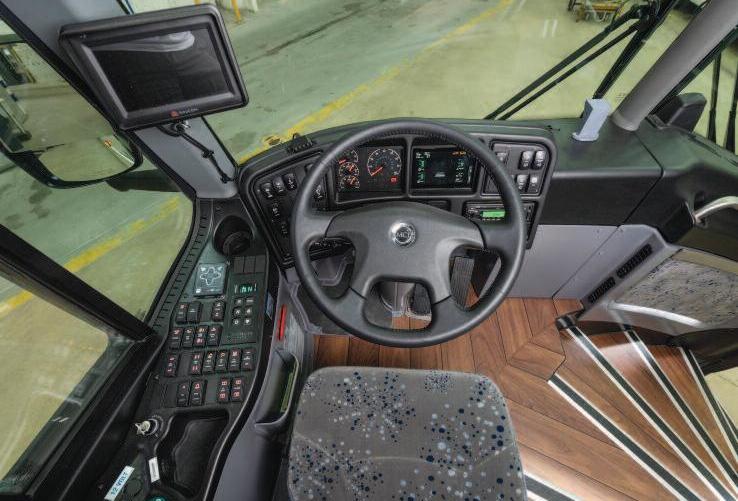
As with the other Next Generation “D” models, the D4520 incorporates the new design and technology introduced by the D45 CRT LE. Drivers will appreciate the narrower pillars that increase driver visibility. Other updates include a redesigned ergonomic dash and a lower instrument panel that provides better sight lines while putting intuitive controls within reach.
The new D4520 model is somewhat of the flagship of the Next Generation “D” models. It combines the heritage of durability and reliability that have become an MCI tradition with the new design and technology. It is designed for scheduled route service as well as other operations requiring extra durability and replaces the D4505 model in the MCI product line.

The D4520 will continue to offer a wide range of passenger amenities as well as some new options. There is space for up to 60 passengers with various seat models available that incorporate three-point seat belts. Standard equipment includes a chemical-type lavatory as well as an audio/video system with six 15-inch LED wide screen monitors.
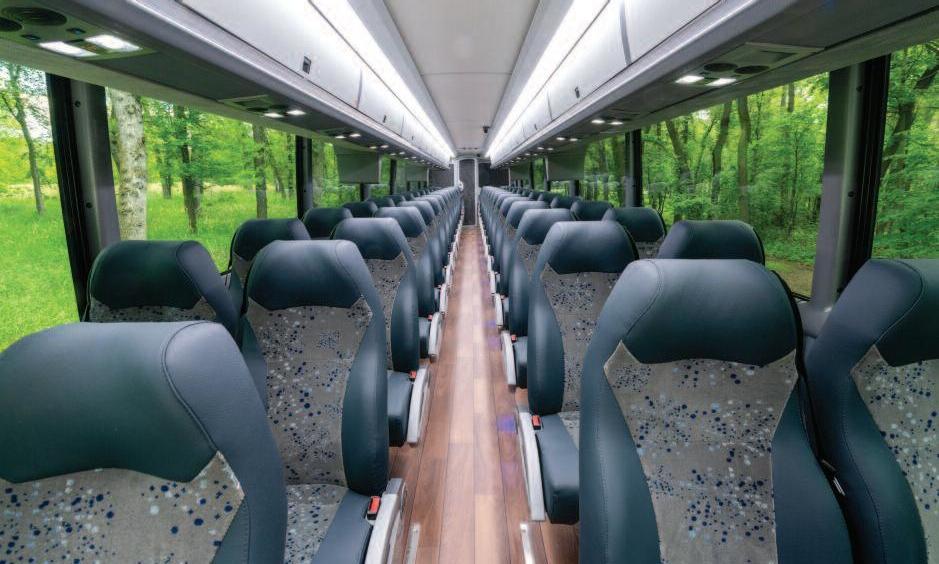
from NFI parts. In addition, MCI has strategically located Service Centers to assist with routine maintenance, complex diagnostics and warranty repairs.
A Look at the New D4520
The D4520 is essentially the flagship model of the Next Generation “D” models. With a length of 45 feet and a high-level passenger cabin, it effectively replaces the D4505 in the MCI product line. It is geared primarily for scheduled service and for rugged use by private operators. The D4520 offers a combination of the traditional MCI reliability and durability with the new styling and improvements found in the Next Generation “D” models.
Provided as a drive train is a Cummins X12 410-horsepower clean diesel engine with an engine brake coupled to an Allison B500 Gen V transmission. The engine compartment is electronically cooled with an electrically driven fan array. All three axles are from ZF and tires are R22.5 9.00” . The brakes on the D4520 are Bendix ADB22X. Exterior lighting and headlights are LED. An electronically-controlled air suspension system is provided with high/low ride and a kneeling function. As expected, the battery system includes two 8D batteries and provides both 12 and 24 volts.
In exterior dimensions, the length including bumpers is 45 feet and 10 inches. Width is the expected 102 inches and height is 138.6 inches – about 111⁄2 feet. Turning radius is 41 feet, nine inches. Since this coach is designed for scheduled and charter service, it has full underfloor luggage compartments with pantograph doors and a pneumatic locking system. An impressive 560 cubic feet (this includes parcel rack space – 445 cubic ft below floor) of underfloor space is provided on the diesel-powered coach.
The passenger compartment includes space for up to 60 passengers. Overhead open parcel racks are standard with LED reading lights and airflow control. Achemical-type lavatory without a sink is provided. Also provided as standard equipment is an audio/video system with a dash mounted DVD and six 15-inch LCD wide screen monitors. Optional items include 110-volt outlets, WiFi, iPod and MP3 connections and a wireless microphone. A rear window is also optional.
An impressive array of safety features is provided as standard equipment on the D4520. Included is Electronic Stability Control (ESC), Automatic Traction Control (ATC), disc brakes with six-channel antilock braking system (ABS), the Amerex fire detection and suppression system and a Tire Pressure Monitoring System (TPMS) is also standard. For the passengers there are multiple seat models with three-point seat belts. Drivers will like the tilt and telescoping steering wheel, cruise control and the SmarTire™ integrated tire pressure monitoring system.
A wide range of optional equipment and features are also available on the D4520. This includes a rear-mounted Braun wheelchair lift with two wheelchair positions, parcel rack air conditioning, fabric interior packages and Alcoa Durabrite® aluminum wheels. Other interesting options include a Proheat auxiliary heater, a Bendix Fusion collision mitigation system, video surveillance systems, a 360degree camera system, a sliding battery tray and curb lights.
The D4520 has been in production and can be ordered. In addition to clean diesel power it will also be available with batteryelectric power. As time goes on, other models in the Next Generation “D” series will also be available. q


Absolutely the finest dump valve ever. • Air powered version since 1985. • All parts easily replaceable
DUPREE PRODUCTS Phone: (888) 668-4288 Fax: (905) 374-3796 www.dupreeproducts.com


